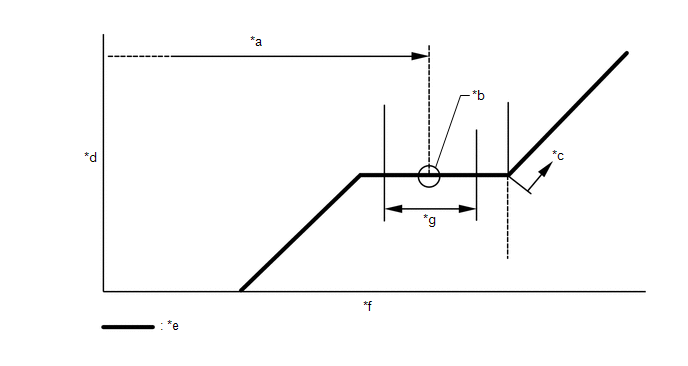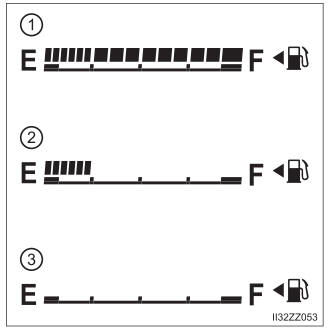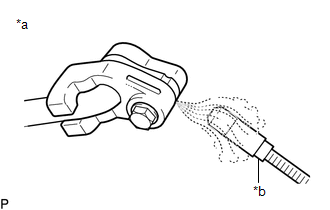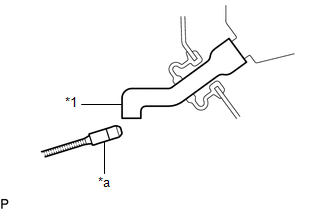Toyota Yaris: Heating / Air Conditioning / Refrigerant (for Hfc-134a(r134a))
Replacement
REPLACEMENT
PROCEDURE
1. RECOVER REFRIGERANT FROM REFRIGERATION SYSTEM
(a) Turn the ignition switch ON.
(b) Operate the compressor under the conditions shown below:
| Item | Condition |
|---|---|
| Operating time | 3 minutes or more |
| Temperature setting | Max cool |
| Blower speed | High |
| Engine | Idling |
| A/C switch | ON |
This causes most of the compressor oil from the various components of the A/C system to collect in the compressor.
HINT:
It is not necessary to operate the compressor if the A/C does not operate because of compressor lock, etc.
(c) Turn the ignition switch off.
(d) Recover the refrigerant from the A/C system using a refrigerant recovery unit.
HINT:
Use the refrigerant recovery unit in accordance with the manufacturer's instruction manual.
2. CHARGE AIR CONDITIONING SYSTEM WITH REFRIGERANT
(a) Perform vacuum purging using a vacuum pump or appropriate equipment.
(b) Charge the air conditioning system with refrigerant.
Refrigerant Type:
HFC-134a (R134a)

| *a | Standard Charge Amount | *b | Mean Value in Proper Range |
| *c | Overcharged | *d | High Pressure |
| *e | Sub-cool System | *f | Refrigerant Amount |
| *g | +/-30 g (+/-1.05 oz.) | - | - |
Standard Charge Amount:
390 to 450 g (13.8 to 15.9 oz.)
SST: 09985-20010
09985-02010
09985-02050
09985-02060
09985-02070
09985-02080
09985-02090
09985-02110
09985-02130
09985-02140
09985-02150
NOTICE:
- Do not turn the A/C switch on before charging the air conditioning system with refrigerant. Doing so may cause the compressor to work without refrigerant, resulting in overheating of the compressor.
- The refrigerant amount should be checked by quantity (weight).
- The graph above is shown for reference only.
HINT:
Ensure that sufficient refrigerant is available to recharge the system when using a refrigerant recovery unit. Refrigerant recovery units are not always able to recover 100% of the refrigerant from an air conditioning system.
3. WARM UP ENGINE
(a) Keep the A/C switch on for at least 2 minutes to warm up the compressor.
NOTICE:
To prevent damage to the compressor, be sure to warm up the compressor when turning the air conditioning on after removing and installing any air conditioning system lines (including the compressor).
4. INSPECT FOR REFRIGERANT LEAK
(a) After recharging the air conditioning system with refrigerant, inspect for refrigerant leaks using a halogen leak detector.
(b) Carry out the test under the following conditions:
- Turn the ignition switch off.
- Ensure good ventilation (the halogen leak detector may react to volatile gases which are not refrigerant, such as gasoline vapor and exhaust gas).
- Repeat the inspection 2 or 3 times.
-
Measure the pressure to make sure that there is some refrigerant remaining in the air conditioning system.
Pressure when the compressor is off: approximately 392 to 588 kPa (3.9 to 5.9 kgf/cm2, 57 to 85 psi)
| (c) Using a halogen leak detector, inspect for refrigerant leaks from the air conditioning system. |
|
| (d) Bring the halogen leak detector close to the drain cooler hose with the detector power off, and then turn the detector on. HINT:
|
|
(e) If a refrigerant leak is not detected from the drain cooler hose, remove the blower motor control from the cooling unit. Insert the halogen leak detector sensor into the unit and check for leaks.
(f) Disconnect the pressure sensor connector and leave it for approximately 20 minutes. Bring the halogen leak detector close to the pressure sensor and check for leaks.
HINT:
When checking for leaks, the presence of oily dirt at a joint can indicate a leak.
 Installation
Installation
INSTALLATION PROCEDURE 1. INSTALL NO. 1 COOLER THERMISTOR (a) Install the No. 1 cooler thermistor as shown in the illustration. Installation Position: Part Length A 45 to 55 mm (1...
 Refrigerant Line
Refrigerant Line
ComponentsCOMPONENTS ILLUSTRATION
*1 PIPING CLAMP *2 SUCTION HOSE SUB-ASSEMBLY *3 O-RING *4 AIR CONDITIONER TUBE AND ACCESSORY ASSEMBLY *5 NO...
Other information:
Toyota Yaris XP210 (2020-2026) Reapir and Service Manual: Lost Communication with Front Right Air Mix Damper Control Servo Motor LIN Missing Message (B145A87)
DESCRIPTION The air conditioning harness assembly connects the air conditioning amplifier assembly and the No. 1 air conditioning radiator damper servo sub-assembly. The air conditioning amplifier assembly supplies power and sends operation instructions to No...
Toyota Yaris XP210 (2020-2026) Reapir and Service Manual: Transmission Fluid Temperature Sensor "A" Circuit Short to Battery or Open (P071015)
DESCRIPTION Refer to DTC P071015. Click here DTC No. Detection Item DTC Detection Condition Trouble Area MIL Memory Note P071015 Transmission Fluid Temperature Sensor "A" Circuit Short to Battery or Open Manual transaxle oil temperature sensor (temperature sensor) output voltage exceeds 4...
Categories
- Manuals Home
- Toyota Yaris Owners Manual
- Toyota Yaris Service Manual
- Opening and Closing the Liftgate/Trunk Lid
- Removal
- Battery Monitor Module General Electrical Failure (P058A01)
- New on site
- Most important about car
Fuel Gauge
The fuel gauge shows approximately how much fuel is remaining in the tank when the ignition is switched ON. We recommend keeping the tank over 1/4 full.



